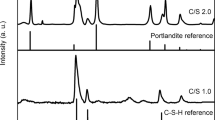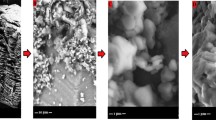Abstract
Environmental hazards due to alkali elution can be mitigated by investigating the dissolution kinetics of calcium silicate mineral phases in water. This study demonstrated the effect of the silicate skeleton structure on the dissolution kinetics of calcium silicate mineral phases in water. The time dependence of the Ca-Si relative release ratio during leaching indicated the preferential elution of Ca to Si in the initial stage of dissolution. The formation of a Ca-depleted layer on the surface of the leached sample was confirmed by X-ray photoelectron spectroscopy and time-of-flight secondary-ion mass spectrometry. The elution kinetics of Ca and Si were determined by the semi-infinite diffusion model and the detachment reaction of the intermediate phase that was formed on the surface of the mineral by hydration, respectively. Furthermore, the nanoscale intermediate phase was observed by transmission electron microscopy. The diffusion coefficient of Ca in the leached layer and the reaction-rate coefficient of Si were obtained from the elution kinetics of Ca and Si, respectively, and these decreased with the increase in the degree of polymerization of the silicate skeleton structure that varied in the following sequence: calcio-olivine (γ-Ca2SiO4) > rankinite (Ca3Si2O7) ≈ wollastonite (β-CaSiO3) > pseudowollastonite (α-CaSiO3).












Similar content being viewed by others
References
Z. Zhu, X. Gao, S. Ueda, and S. Kitamura: ISIJ Int., 2019, vol. 59, pp. 1908-1916.
A. J. Hobson, D. I. Stewart, R. J. G. Mortimer, W. M. Mayes, M. Rogerson, and I. T. Burke: Waste Manag., 2018, vol. 81, pp. 1-10.
R. Ragipani, S. Bhattacharya, and A. K. Suresh: Proc. R. Soc. A, 2019, vol. 475, pp. 1-20.
I. Strandkvist, B. Björkman, and F. Engström: Can. Metall. Q., 2015, vol. 54, pp. 446-454.
T. Maeda, T. Banba, and O. Mizuno: J. Jpn. Soc. Waste Manage. Experts, 2004, vol. 15, pp. 45-51.
S. Yokoyama, A. Suzuki, M. Izaki, and M. Umemoto: Tetsu-to-Hagané, 2009, vol. 95, pp. 434-443 (in Japanese).
S. N. Lekakh, C. H. Rawlins, D. G. C. Robertson, V. L. Richards, and K. D. Peaslee: Metall. Mater. Trans. B, 2008, vol. 39, pp. 125-134.
L. De Windt, P. Chaurand, and J. Rose: Waste Manag. 2011, vol. 31, pp. 225-235.
S.L. Brantley, J.D. Kubicki, and A.F. White: Kinetics of Water-Rock Interaction, Eds., Springer, New York, NY, 2008, pp. 151–210.
G. W. DeVore: J. Geol., 1956, vol. 64, p. 31.
R. Petrović, R. A. Berner, and M. B. Goldhaber: Geochim. Cosmochim. Acta, 1976, vol. 40, pp. 537-548.
J. Schott, R. A. Berner, and E. L. Sjöberg: Geochim. Cosmochim. Acta, 1981, vol. 45, pp. 2123-2135.
W. H. Casey, H. R. Westrich, J. F. Banfield, G. Ferruzzi, and G. W. Arnold: Nature, 1993, vol. 366, pp. 253-256.
J. Schott, O. S. Pokrovsky, O. Spalla, F. Devreux, A. Gloter, and J. A. Mielczarski: Geochim. Cosmochim. Acta, 2012, vol. 98, pp. 259-281.
R. W. Luce, R. W. Bartlett, and G. A. Parks: Geochim. Cosmochim. Acta, 1972, vol. 36, pp. 35-50.
A. C. Lasaga: J. Geophys. Res., 1984, vol. 89, pp. 4009-4025.
F. Ruan, S. Kawanishi, S. Sukenaga, and H. Shibata: ISIJ Int., 2020, vol. 60, pp. 419-425.
Y. Chen, and S. L. Brantley: Chem. Geol., 1997, vol. 135, pp. 275-290.
W. H. Casey, and G. Sposito: Geochim. Cosmochim. Acta, 1992, vol. 56, pp. 3825-3830.
R. Hellmann, R. Wirth, D. Daval, J. Barnes, J. Penisson, D. Tisserand, T. Epicier, B. Florin, and R. L. Hervig: Chem. Geol., 2012, vol. 294-295, pp. 203-216.
G. Yuan, Y. Cao, H. Schulz, F. Hao, J. Gluyas, K. Liu, T. Yang, Y. Wang, K. Xi, and F. Li: Earth-Sci. Rev., 2019, vol. 191, pp. 114-140.
B. O. Mysen, D. Virgo, and F. A. Seifert: Rev. Geophys. Space Phys., 1982, vol. 20, pp. 353-383.
G. R. Holdren, and P. M. Speyer: Am. J. Sci., 1985, vol. 285, pp. 994-1026.
L. Black, K. Garbev, P. Stemmermann, K. R. Hallam, and G. C. Allen: Wasser-und Geotechnologie Jahrgang, 2002, vol. 2, pp. 19-30.
L. Black, K. Garbev, P. Stemmermann, K. R. Hallam, and G. C. Allen: Phys. Chem. Miner., 2004, vol. 31, pp. 337-346.
L. Chou, and R. Wollast: Geochim. Cosmochim. Acta, 1984, vol. 48, pp. 2205-2217.
L. Chou, and R. Wollast: Am. J. Sci., 1985, vol. 285, pp. 963-993.
E. S. Chardon, F. R. Livens, and D. J. Vaughan: Earth-Sci. Rev., 2006, vol. 78, pp. 1-26.
R. Wollast: Geochim. Cosmochim. Acta, 1967, vol. 31, pp. 635-648.
T. Paces: Geochim. Cosmochim. Acta, 1973, vol. 37, pp. 2641-2663.
Y. Nakano, S. Hasumoto, Z. Uchida, H. Shiratsuchi, and T. Hitomi: Proceedings of the 60th Annual Conference of the Japan Society of Civil Engineers, 2005, vol. 5, pp. 453–54 (in Japanese).
S. Sutou, K. Haga, M. Hironaga, S. Tanaka, and S. Nagasaki:Journal of Japan Society of Civil Engineers, 2004, vol. 62, pp. 13-22. (in Japanese)
M. Buil, E. Revertegat, and J. Oliver: 1992, In: Gilliam T. M. and Wiles C. C. Eds. Stabilization and Solidification of Hazardous, Radioactive, and Mixed Wastes, 2nd Volume, STP, 1123. Philadelphia: ASTM, 227-241.
K. Nakarai, T. Ishida, T. Usui, and K. Maekawa: Proceedings of the Japan concrete institute, 2005, vol. 27, pp. 715-720. (in Japanese)
A.C. Lasaga and R.J. Kirkpatrick: Rev. Mineral., Volume 8: Kinetics of Geochemical Processes, Eds., Mineralogical Society of America, Washington, D.C., 1981, pp. 1–67.
E. Busenberg, and C. V. Clemency: Geochim. Cosmochim. Acta, 1976, vol. 40, pp. 41-49.
F. Lin, & C. V. Clemency: Geochim. Cosmochim. Acta, 1981, vol. 45, pp. 571-576.
J. D. Rimstidt and H. L. Barnes: Geochim. Cosmochim. Acta, 1980, vol. 44, pp. 1683-1699.
I. G. Richardson, and G. W. Groves: J. Mater. Sci., 1997, vol. 32, pp. 4793-4802.
O. S. Pokrovsky, and J. Schott: Geochim. Cosmochim. Acta, 2000, vol. 64, pp. 3313-3325.
Acknowledgments
This work was financially supported in part by a Grant-in-Aid for Scientific Research (B) Grant (No. 19H02487) from the Japan Society for the Promotion of Science (JSPS). The authors would like to thank Ms. Shishido (Tohoku University) for technical support in ToF-SIMS analysis. The authors would also like to thank Prof. Nagasako and Mr. Ito (Tohoku University) for their help with the TEM observations.
Author information
Authors and Affiliations
Corresponding author
Additional information
Publisher's Note
Springer Nature remains neutral with regard to jurisdictional claims in published maps and institutional affiliations.
Manuscript submitted September 9, 2020; December 10, 2020.
Appendices
Appendix 1
The XRD patterns of the prepared bulk mineral samples are shown in Figure A1. The diffraction peaks with filled dot represent the corresponding crystalline mineral phase. The identification results confirmed that each bulk mineral sample comprised the corresponding crystalline calcium silicate phase with a high purity and no impurity phases were identified.
Appendix 2
The O 1s spectrum that was obtained by XPS was analyzed to distinguish the bonding states and reveal the structural changes due to the hydration reaction. The development of the leached layer on the surface of the mineral phase was investigated from the depth analysis. The results of the peak determination of the pristine mineral phases and the peak separation of the leached mineral phases are analyzed in this section. A Shirley background and Gaussian peak shape were assumed for all the peaks in the O 1s spectrum. The difficulty in the quantitative analysis was attributed to the presence of the NBO, BO, OH groups, H2O molecules, and the carbonates that were generated by the carbonation reaction during the leaching tests.
The peak determination for the pristine mineral phases involved the calculation of BE and the full width at half maximum (FWHM) of the NBO and BO based on the knowledge of the silicate structure of each mineral phase. The BO : NBO intensity ratio in the unreacted γ-Ca2SiO4, Ca3Si2O7, and α-CaSiO3 were 0 (no BO peak), 1:6, and 1:2, respectively. β-CaSiO3 was not considered due to its uncertain BO : NBO intensity ratio that depended on the length of the single chain. The C 1s peaks (BE = 289.5 ± 0.5 eV) in the XPS spectra of γ-Ca2SiO4 and Ca3Si2O7 were assigned to the carbonates. The atomic ratio of carbon to oxygen (C/O = 3:1) was also considered in the peak separation analysis. The peak determination results of the pristine target mineral phases are shown in Figure A2. The fit of the experimental data with the O 1s spectrum of each unreacted phase was satisfactory. This indicated the consistency in the BE and FWHM of O 1s-NBO, O 1s-BO, and O 1s-CO 2-3 that were obtained from each mineral phase.
The depth from the surface to the interior of the minerals was corresponded to the sputtering time during the analysis of the peak separation of the leached mineral phases. The charge-corrected O 1s spectra of the leached bulk mineral phases at different depths from the surface are shown in Figure A3. The asymmetric nature of all the O 1s spectra was attributed to the presence of BO, NBO, OH groups, and H2O molecules. The peak determination results for the various O 1s bonding states were fitted to the O 1s spectra near the surface of the leached bulk samples, and the peak separation results are shown in Figure A3. The presence of an additional peak with the peaks of O 1s-NBO and O 1s-CO 2−3 in the O 1s spectrum of the bulk γ-Ca2SiO4 sample (leaching time = 6 h) (Figure A3(a)) was attributed to the influence of the leaching process. The additional peak either corresponded to the bonding states such as O 1s-BO, O 1s-OH, and O 1s-H2O or was a mixture (O 1s-BO/OH/H2O) of the three bonding states. The presence of an additional peak with the peaks of O 1s-NBO, O 1s-BO, and O 1s-CO 2-3 was also observed in the O 1s spectrum of the bulk Ca3Si2O7 sample (leaching time = 12 h) (Figure A3(b)). The additional peak either corresponded to the hydrated bonding states such as O 1s-OH and O 1s-H2O or was a mixture (O 1s-OH/H2O) of the two bonding states. The additional peak in the O 1s spectra of the α-CaSiO3 bulk (leaching time = 48 h) (Figure A3(c)) was assigned to O 1s-OH/H2O; furthermore, carbonation was not detected.
Rights and permissions
About this article
Cite this article
Ruan, F., Kawanishi, S., Sukenaga, S. et al. Effect of the Silicate Skeleton Structure on the Dissolution Kinetics of Calcium Silicate Mineral Phases in Water. Metall Mater Trans B 52, 1071–1084 (2021). https://doi.org/10.1007/s11663-021-02079-9
Received:
Accepted:
Published:
Issue Date:
DOI: https://doi.org/10.1007/s11663-021-02079-9







